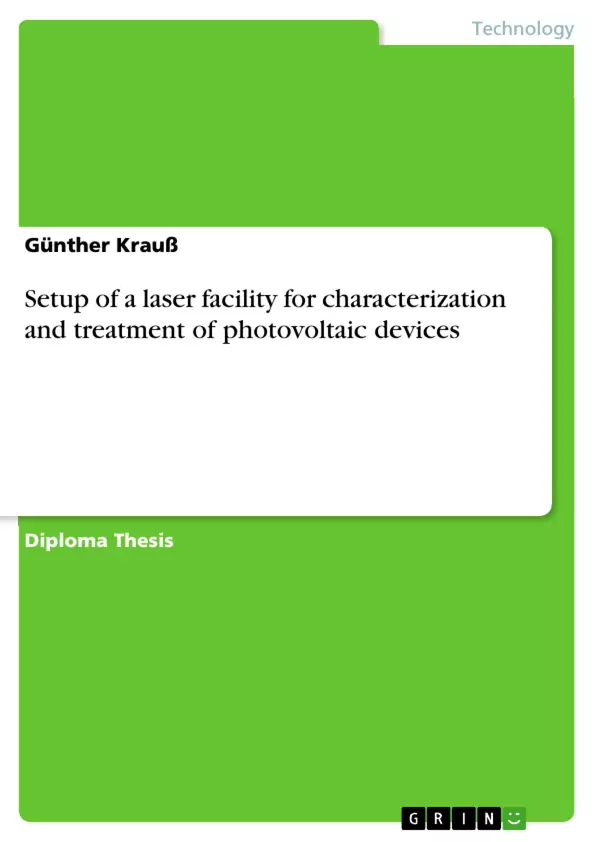Die Diplomarbeit wurde von mir in englischer Sprache verfaßt, da die Arbeit im Zuge eines LEONARDO DA VINCI Traineeship Programmes am CIEMAT (Centro de Investigaciones Energéticas, Medioambientales y Technológicas, Madrid, Spain) durchgeführt wurde und auch von der politechnischen Universität (Institut für Solarenergie) betreut wurde.
Diese Diplomarbeit beschreibt das Design und die Montage eines experimentellen Systems zur Charakterisierung und Strukturierung von Solarzellen und anderen Photovoltaikbauteilen.
Das designte Lasersystem kombiniert ein Werkzeug zur Strukturierung von Dünnschichtsolarzellen mit einer Charakterisierungseinheit (,,Photoresponse Mapping"-Technik)
Das Charakterisierungsteilsystem arbeitet nach dem LBIC-Prinzip (laser beam induced currents). Das System zur Strukturierung von dünnen Schichten arbeitet mit einem NdYAG Lasercutter, der gewöhnlicherweise auch zu IC-Reparaturen verwendet wird.
Ziel dieser Diplomarbeit ist der ,,Set-Up" des Doppel-Lasersystems, welches die Anstrengungen in der Forschungsarbeit der Entwicklung neuer Materialen für Solarzellen und deren Charakterisierung unterstützen soll.
Benutzt man Standardmethoden (I-V Kurven, Spektrale Empfindlichkeit), um optische-elektrische Eigenschaften einer Solarzelle zu messen, erhält man ein quantitatives Ergebnis, das einem keine Rückschlüsse auf lokale Defekte innerhalb der Probe erlaubt. Kleine Defekte innerhalb eines photovoltaischen Bauelementes können die Leistung dieses Bauteils negativ beeinflussen. Der Vorteil der ,,Photoresponse-Mapping" -Technik liegt in der Möglichkeit, lokale Messungen am Bauteil vorzunehmen.
"Laser-Scribing" ist eine Schlüsseltechnologie im Herstellungsprozess von amorphen Silizium-Solarzellen. Diese Technologie deckt bereits 50% des Fabrikationsprozesses ab und hat die konventionelle Methode mittels Photolithografie bereits komplett ersetzt. [1]
Der erste Teil dieser Arbeit soll in das Thema einführen und erläutert die vorgegebene Aufgabenstellung.
Inhaltsverzeichnis (Table of Contents)
- 1 Introduction
- 2 Physical principles of silicon solar cell characterization
- 2.1 Conventional structure of a silicon solar cell
- 2.2 Operating principles of silicon solar cells.
- 2.3 Semiconductors under illumination..........\n2.3.1 Absorption of light……………………………….\n142.3.2 Photoconductivity.\n2.3.3 Photocurrent generation in p-n junction solar cells.....\n2.3.3 Quantum efficiency
- 2.4 Saturation and recombination current
- 2.5 Equivalent circuit of a solar cell ………………………..\n2.6 Fundamental parameter for solar cell characterization
- 3 Experimental issues - Hardware..........\n3.1 Global system description....……………………………………\n3.2 Laser characterization system ......\n3.2.1 He-Ne laser\n3.2.2 Beam intensity monitoring.\n19\n.......... 28\n.31\n33\n.....36\n.........\n.36\n3.2.3 Electrical measurements ………………………………….\n3.3 Laser-scribing system.….………………………..\n3.3.1 Nd-YAG laser...………………\n3.3.2 Optical system.\n3.4 Position control
- 4 Experimental issues - Software ……………………………………………….\n4.1 Main program\n.............\n........\n.........\n.39\n_\n………..40\n……..43\n....44\n…………….. 44\n45\n....47\n............\n……….. 49\n...............49\n…....53\n...........\n.55\n.56\n.....58\n.........\n4.2 Low level programming of microcontrollers....………………………\n4.3 RS-232 programming of the Nd-YAG laser cutter.\n4.4 GPIB programming of digital multimeters ………………………………………………………………………
- 5 Cell characterization - results and discussion\n5.1 Basic principles of photoresponse mapping.\n5.2 Calculations of expected photocurrents.\n5.3 I/V characteristics.\n5.4 Spectral response.\n5.5 Photoresponse mapping
- 6 Prospective......\n6.1 Optical system for improved resolution.\n6.2 Transmittance maps\n..........\n.............\n.59\n…….. 63\n…………………......... 69\n........... 74\n.80\n…………....81\n82\n6.3 UV laser beam for selective scribing.....\n6.4 Selective wavelengths for photoresponse mapping.\n6.5 Lock-in-technique.......
Zielsetzung und Themenschwerpunkte (Objectives and Key Themes)
This thesis describes the design and assembly of an experimental system for the characterization and structuring of solar cells and other photovoltaic components. The designed laser system combines a tool for structuring thin-film solar cells with a characterization unit (,,Photoresponse Mapping“-technique). The objective of this thesis is the “Set up” of the laser system, which is intended to support the research efforts in the development of new materials for solar cells and their characterization. This thesis aims to provide a comprehensive overview of the design and implementation of a laser facility for characterizing and treating photovoltaic devices. The main themes are:
- Physical principles of silicon solar cell characterization
- Experimental issues in hardware and software
- Cell characterization using photoresponse mapping
- Prospective developments for the laser facility
- Potential applications of the system in photovoltaic research
Zusammenfassung der Kapitel (Chapter Summaries)
Chapter 1 introduces the subject matter and the scope of the thesis. It outlines the motivation behind developing the laser system and highlights the key challenges and objectives. Chapter 2 delves into the fundamental principles of silicon solar cell characterization, providing a theoretical background for understanding the physical processes involved in energy conversion. Chapter 3 explores the hardware components of the laser system, describing the individual elements and their integration into a functioning laboratory unit. It also discusses the selection and justification of the software used in the system. Chapter 4 focuses on the software aspects of the system, explaining the programming techniques employed for different interfaces and providing a brief overview of the software's capabilities. Chapter 5 presents the initial experimental results obtained using the laser system. It analyzes the data and discusses the correlations with other opto-electrical characterization methods. Chapter 6 explores potential future developments and enhancements for the laser system, suggesting further research applications.
Schlüsselwörter (Keywords)
The main keywords and focus topics of this thesis include: Laser facility, photovoltaic devices, solar cell characterization, photoresponse mapping, laser-scribing, thin-film solar cells, semiconductor materials, opto-electrical properties, experimental setup, software development, and potential applications in photovoltaic research.
- Citar trabajo
- Günther Krauß (Autor), 1998, Setup of a laser facility for characterization and treatment of photovoltaic devices, Múnich, GRIN Verlag, https://www.grin.com/document/78



